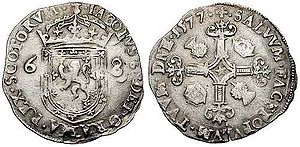Merk (coin)
| James VI: half merk or noble | |
|---|---|

| |
| Crowned Scottish arms flanked by denomination: 6 and 8 | Compound cross fleury, quartered with crowns and thistles |
| 1577 – Silver content 6.57 g (theoretical weight 103.8 grains, equivalent to 6.73 g). Grueber 135 | |
The merk is a long-obsolete Scottish silver coin. Originally the same word as a money mark of silver, the merk was in circulation at the end of the 16th century and in the 17th century. It was originally valued at 13 shillings 4 pence (exactly 2⁄3 of a pound Scots, or about one English shilling), later raised to 14s. Scots.[1]
In addition to the merks, coins issued include the four merk worth 56s or £2-16; the half merk (or ), 6s-8d or 80d; the quarter merk, 3s-4d or 40d; the eighth-thistle merk, worth 20d.
The first issue weighed 103.8 grains (6.73 g) and was 50% silver and 50% base metals,[2] thus it contained 51.9 grains (0.108 troy ounces; 3.36 grams) of silver.
"Markland", or "Merkland", was used to describe an amount of land in Scottish deeds and legal papers. It was based upon a common valuation of the land.
During the "Lang Siege" of Edinburgh Castle in 1572, the last phase of the Marian civil war, the goldsmith James Cockie minted half merks in the castle, while the supporters of James VI set up their mint at Dalkeith.[3]
References[]
- ^ Marteau, Pierre, English–Scottish currency converter.
- ^ Grueber, Herbert (1970) [1899], Handbook of the Coins of Great Britain and Ireland in the British Museum, London, ISBN 1-4021-1090-1.
- ^ Harry Potter, Edinburgh Under Siege: 1571-1573 (Stroud, 2003), p. 97.
- Coins of Scotland
- Coin stubs
- Scottish history stubs
